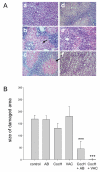Effects of anti-cocaine vaccine and viral gene transfer of cocaine hydrolase in mice on cocaine toxicity including motor strength and liver damage
- PMID: 22935511
- PMCID: PMC3537841
- DOI: 10.1016/j.cbi.2012.08.006
Effects of anti-cocaine vaccine and viral gene transfer of cocaine hydrolase in mice on cocaine toxicity including motor strength and liver damage
Abstract
In developing an vivo drug-interception therapy to treat cocaine abuse and hinder relapse into drug seeking provoked by re-encounter with cocaine, two promising agents are: (1) a cocaine hydrolase enzyme (CocH) derived from human butyrylcholinesterase and delivered by gene transfer; (2) an anti-cocaine antibody elicited by vaccination. Recent behavioral experiments showed that antibody and enzyme work in a complementary fashion to reduce cocaine-stimulated locomotor activity in rats and mice. Our present goal was to test protection against liver damage and muscle weakness in mice challenged with massive doses of cocaine at or near the LD50 level (100-120 mg/kg, i.p.). We found that, when the interceptor proteins were combined at doses that were only modestly protective in isolation (enzyme, 1mg/kg; antibody, 8 mg/kg), they provided complete protection of liver tissue and motor function. When the enzyme levels were ~400-fold higher, after in vivo transduction by adeno-associated viral vector, similar protection was observed from CocH alone.
Copyright © 2012 Elsevier Ireland Ltd. All rights reserved.
Figures



Similar articles
-
Prospects, promise and problems on the road to effective vaccines and related therapies for substance abuse.Expert Rev Vaccines. 2013 Mar;12(3):323-32. doi: 10.1586/erv.13.1. Expert Rev Vaccines. 2013. PMID: 23496671 Free PMC article. Review.
-
Anti-cocaine antibody and butyrylcholinesterase-derived cocaine hydrolase exert cooperative effects on cocaine pharmacokinetics and cocaine-induced locomotor activity in mice.Chem Biol Interact. 2013 Mar 25;203(1):212-6. doi: 10.1016/j.cbi.2012.08.015. Epub 2012 Aug 31. Chem Biol Interact. 2013. PMID: 22960160 Free PMC article.
-
Combined cocaine hydrolase gene transfer and anti-cocaine vaccine synergistically block cocaine-induced locomotion.PLoS One. 2012;7(8):e43536. doi: 10.1371/journal.pone.0043536. Epub 2012 Aug 17. PLoS One. 2012. PMID: 22912888 Free PMC article.
-
Reward and Toxicity of Cocaine Metabolites Generated by Cocaine Hydrolase.Cell Mol Neurobiol. 2015 Aug;35(6):819-26. doi: 10.1007/s10571-015-0175-9. Epub 2015 Mar 27. Cell Mol Neurobiol. 2015. PMID: 25814464 Free PMC article.
-
Interception of cocaine by enzyme or antibody delivered with viral gene transfer: a novel strategy for preventing relapse in recovering drug users.CNS Neurol Disord Drug Targets. 2011 Dec;10(8):880-91. doi: 10.2174/187152711799219398. CNS Neurol Disord Drug Targets. 2011. PMID: 22229308 Free PMC article. Review.
Cited by
-
Systemic Safety of a Recombinant AAV8 Vector for Human Cocaine Hydrolase Gene Therapy: A Good Laboratory Practice Preclinical Study in Mice.Hum Gene Ther. 2020 Jan;31(1-2):70-79. doi: 10.1089/hum.2019.233. Epub 2019 Dec 19. Hum Gene Ther. 2020. PMID: 31650869 Free PMC article.
-
Kinetic characterization of cholinesterases and a therapeutically valuable cocaine hydrolase for their catalytic activities against heroin and its metabolite 6-monoacetylmorphine.Chem Biol Interact. 2018 Sep 25;293:107-114. doi: 10.1016/j.cbi.2018.08.002. Epub 2018 Aug 4. Chem Biol Interact. 2018. PMID: 30080993 Free PMC article.
-
The future potential for cocaine vaccines.Expert Opin Biol Ther. 2014 Sep;14(9):1271-83. doi: 10.1517/14712598.2014.920319. Epub 2014 May 16. Expert Opin Biol Ther. 2014. PMID: 24835496 Free PMC article. Review.
-
Preparation and in vivo characterization of a cocaine hydrolase engineered from human butyrylcholinesterase for metabolizing cocaine.Biochem J. 2013 Aug 1;453(3):447-54. doi: 10.1042/BJ20130549. Biochem J. 2013. PMID: 23849058 Free PMC article.
-
Prospects, promise and problems on the road to effective vaccines and related therapies for substance abuse.Expert Rev Vaccines. 2013 Mar;12(3):323-32. doi: 10.1586/erv.13.1. Expert Rev Vaccines. 2013. PMID: 23496671 Free PMC article. Review.
References
-
- Shuster L, Quimby F, Bates A, Thompson ML. Liver damage from cocaine in mice. Life Sci. 1977;20:1035–41. - PubMed
Publication types
MeSH terms
Substances
Grants and funding
LinkOut - more resources
Full Text Sources
Other Literature Sources
Medical

